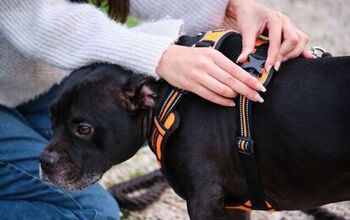How to Walk a Senior Dog


As your dog gets older, he is going to slow down a little bit. He may develop arthritis or other joint problems and he just won’t be as energetic as he once was. Just because your dog is a little older and a little slower, however, doesn’t mean you should skip his daily walk – he still needs regular exercise to control his weight and maintain his health. Keep reading to receive tips for walking an older dog.
Why is Exercise Important for Senior Dogs?
While your dog may become less active and energetic as he ages, regular activity is still important. Have you ever woken up feeling sore? It may have been because you slept in a strange position or simply because you weren’t using your muscles and joints for an extended period of time – the same can happen to your dog if you stop walking him on a daily basis.
Related: Top 5 Ways to Keep a Senior Dog Mentally Sharp
A body that doesn’t move isn’t healthy, and long periods of immobility can increase your dog’s risk for developing arthritis and other musculoskeletal issues. Regular, gentle exercise will help keep your dog’s joints lubricated, his muscles supple, and his bones strong. It also supports healthy circulation and may reduce inflammation. Plus, regular exercise can boost his mood and improve his quality of life.
Tips for Walking an Older Dog
First and foremost, you need to make sure that your dog is approved for regular activity. If he has severe osteoarthritis or other musculoskeletal problems that affect his mobility, your veterinarian may recommend an alternative form of exercise. Once your dog becomes a senior, he should have a thorough exam to make sure he is still healthy enough for regular exercise.
Related: Paddling With A Senior Pooch
Once you’ve determined that it is safe to walk your aging dog, here are some simple tips to follow:
- Start off slowly. If your dog hasn’t exercised for a while or if you’re hoping to increase his activity, make gradual changes so you don’t put excess strain on his aging muscles and joints.
- Consider the conditions. As your dog gets older, he may be more sensitive to heat or cold, so check the weather before you head out on your walk.
- Protect his feet. If your dog has been inactive for a while, the pads on his feet may not be as strong as they once were. If you’re walking on hot asphalt, cold concrete, or rough terrain, you might want to have him wear booties to protect his feet.
- Take breaks as needed. Don’t force your dog to walk farther than he is able to without pain. If he starts to struggle, take a break. You should also take frequent water breaks in hot weather.
- Pay close attention. As you walk your older dog, pay attention for any signs of change in his behavior or mobility that could signal a problem. Report symptoms to your vet and reassess your exercise strategy if needed.
Every dog is unique, so you’ll need to cater your dog’s exercise routine to his ability and fitness level. Keep in mind that your dog’s mobility may change as he continues to age, to just keep an eye on him and stay up to date with vet visits to make sure he is in good enough health for regular walks.

Kate Barrington is the loving owner of two cats (Bagel and Munchkin) and a noisy herd of guinea pigs. Having grown up with golden retrievers, Kate has a great deal of experience with dogs but labels herself a lover of all pets. Having received a Bachelor's degree in English, Kate has combined her love for pets and her passion for writing to create her own freelance writing business, specializing in the pet niche.
More by Kate Barrington























